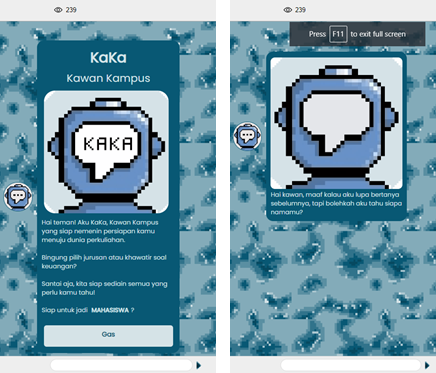Main Article Content
Abstract
Technology has a crucial role in information dissemination, creating a need for interactive and user-friendly communication tools. One of tools that can be used in this research is chatbot. Chatbots serve as effective intermediaries in the information exchange process, providing a simple and interactive interface. This research aims to develop a Button-Based Chatbot using the Smojo AI platform, with an easy-to-use interface for delivering college preparation information to prospective students. The development of the chatbot employs the SDLC Waterfall method. The chatbot is named "KaKa: Campus Companion" and it provides information on interest tests recommendations, effective study methods, admission pathways to public universities, and scholarship recommendations. The results of this research demonstrate the successful development of a chatbot that delivers simple and interactive information. The implementation of the SDLC Waterfall method in chatbot development ensures a well-structured and coordinated approach, focusing on each menu within the chatbot. Based on the test results, which have been carried out both white-box and black-box testing, the application can run correctly 100% and UAT testing with an accuracy level of 91%.
Keywords
Article Details

This work is licensed under a Creative Commons Attribution-NonCommercial 4.0 International License.
References
- B. R. Ranoliya, N. Raghuwanshi, and S. Singh, “Chatbot for university related FAQs,” 2017 International Conference on Advances in Computing, Communications and Informatics (ICACCI), Sep. 2017, doi: https://doi.org/10.1109/icacci.2017.8126057
- Z. Sa’diyah, K. E. Aziz, M. H. Dardiri, and M. A. Yaqin, “Pengembangan Web Service Sistem Informasi Sekolah,” Jurasik (Jurnal Riset Sistem Informasi dan Teknik Informatika), vol. 5, no. 1, p. 154, Mar. 2020, doi: https://doi.org/10.30645/jurasik.v5i1.180
- A. Gupta, “Introduction to AI Chatbots,” International Journal of Engineering Research and, vol. V9, no. 07, Jul. 2020, doi: https://doi.org/10.17577/ijertv9is070143
- K. Istiqomah, V. Setyaningrum, & D. S. Atmaja. (2023). Pengembangan Bahan Ajar Chatbot Berbasis Artificial Intelligence Materi Sistem Peredaran Darah Manusia Kelas V. Perspektif Pendidikan Dan Keguruan, 14(1), 50–56. https://doi.org/10.25299/perspektif.2023.vol14(1).12455
- A.R. Akbar, D. Putra, N.P.L. Suryalaksono, & N.D. Priyawati, “Rancang Bangun Website Asesmen Psikologi Menggunakan Framework React JS dan Metode SDLC Agile,” Jurnal Abdi Teknoyasa, pp. 157–163, Jul. 2023, doi: https://doi.org/10.23917/abditeknoyasa.v4i1.1302
- P. Smutny, & P. Schreiberova, (2020). Chatbots for learning: A review of educational chatbots for the Facebook Messenger. Computers & Education, 151(103862), 103862. https://doi.org/10.1016/j.compedu.2020.103862
- D. Rudhistiar, R. P. Prasetya, D. Abdurrohman, & Muhammad. (2022). Pembangunan dan Pengembangan Sistem Chat Bot SPADA Menggunakan Telegram. Prosiding SENIATI, 6(3), 472–477. https://doi.org/10.36040/seniati.v6i3.5073
- M. Wijaya, Junaedy, and Hamdan Arfandy, “Perancangan Chatbot Untuk Informasi Penerimaan Mahasiswa Baru Pada Stmik Kharisma Makassar,” KHARISMA Tech, vol. 14, no. 1, pp. 14–23, Apr. 2019.
- A. Santoso, A.S. Winarsih, N., Mulyanto, E., Wilujeng, G.E. Sukmana, S.S. Rustad, S. Rohman, M., Nugraha, A., & F. Firdausillah, (2018). Dinus Intelligent Assistance (DINA) Chatbot for University Admission Services. 2018 International Seminar on Application for Technology of Information and Communication. https://doi.org/10.1109/isemantic.2018.8549797
- J. Hill, W. Randolph Ford, and I. G. Farreras, “Real conversations with artificial intelligence: A comparison between human–human online conversations and human–chatbot conversations,” Computers in Human Behavior, vol. 49, pp. 245–250, Aug. 2015, doi: https://doi.org/10.1016/j.chb.2015.02.026
- R. Sutoyo, A. Chowanda, A. Kurniati, and R. Wongso, “Designing an Emotionally Realistic Chatbot Framework to Enhance Its Believability with AIML and Information States,” Procedia Computer Science, vol. 157, pp. 621–628, 2019, doi: https://doi.org/10.1016/j.procs.2019.08.226
- Y. W. Chandra and S. Suyanto, “Indonesian Chatbot of University Admission Using a Question Answering System Based on Sequence-to-Sequence Model,” Procedia Computer Science, vol. 157, pp. 367–374, 2019, doi: https://doi.org/10.1016/j.procs.2019.08.179
- N. P. Patel, D. R. Parikh, D. A. Patel, and R. R. Patel, “AI and Web-Based Human-Like Interactive University Chatbot (UNIBOT),” 2019 3rd International conference on Electronics, Communication and Aerospace Technology (ICECA), Jun. 2019, doi: https://doi.org/10.1109/iceca.2019.8822176.
- A. Nursetyo, D. R. I. M. Setiadi, and E. R. Subhiyakto, “Smart Chatbot System for E-Commerce Assitance based on AIML,” IEEE Xplore, Nov. 01, 2018. doi: https://doi.org/10.1109/ISRITI.2018.8864349.
- Ardiansyah Ardiansyah, “Pendampingan Perancangan Chatbot Sebagai Media Interaktif Dalam Menghadapi Tantangan Era Digitalisasi,” vol. 2, no. 1, pp. 44–55, Feb. 2023, doi: https://doi.org/10.34312/ljpmt.v2i1.18078
- E. N. S. C. P and I. Afrianto, “Rancang Bangun Aplikasi Chatbot Informasi Objek Wisata Kota Bandung Dengan Pendekatan Natural Language Processing,” Komputa : Jurnal Ilmiah Komputer dan Informatika, vol. 4, no. 1, pp. 49–54, Mar. 2015, doi: https://doi.org/10.34010/komputa.v4i1.2410

